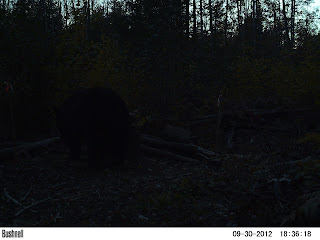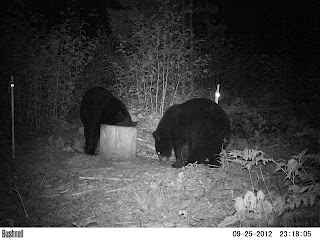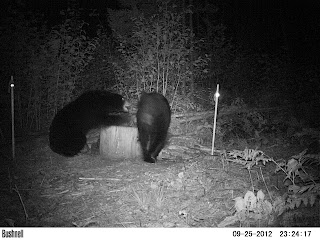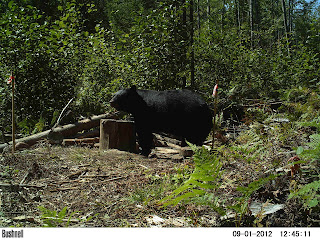In Wisconsin, a hunter may use bait to attract a bear to a particular location. This is a relatively popular and common way to hunt bears. Unlike deer hunting where a hunter might set up on a well-used deer trail and wait for a deer, the success rate of this kind of hunting for black bears would be very low. Black bears are generally nocturnal and very 'secretive' in how they traverse the land.
The Wisconsin DNR has a very basic, good set of baiting rules for hunting black bears. There are a few nuances and other details I'm leaving out, but the main rules are:
- Baiting may begin April 15th the year you have a tag
- Bait may not exceed 10 gallons at a time
- Bait can be any food item except for 'animal parts' or 'animal by-product' (read this as meat, bones, grease etc)
- Bait must be placed in an enclosure made of natural products (ie., can be a human-made hollow log, but cannot be a 5 gallon plastic pail) that is not readily accessible to deer
So, the choices for a bear hunter in Wisconsin is when to start baiting, what to put it in, and what to get for bait!
For my hunt...
When to start baiting:
The DNR allows a hunter to start baiting in mid-April. The hunting season doesn't start until September. In general, the longer you bait, the better the opportunity to draw in large bears. This is because as bears find the bait and eat from it, the food (and therefore scent) gets stuck to their paws. When they walk away from the bait and travel upwards of a mile in any direction from the bait, it creates a wonderful web of sweet-smelling scent trails for other wandering bears to find and follow to the bait.
I started my bait station in mid-July. This was partly due to my ability to get up north and get everything situated as well as my desire to start the bait just shy of two months before the start of the season. I felt any shorter would have compromised my ability to draw a variety of bears in, and anything longer would be a waste of money/effort/bait. I can tell you that so far, I'm happy with my decision. As I write this, my trail camera would indicate that I have two or three different bears frequenting the bait. I'll post about these bears on a future date. So far, things are looking just about right!
What to put it in:
This was a pretty simple task - I just needed to follow the example that my Uncle and Dad used in 2007. I found a naturally hollowed-out log from a large white oak tree. Using a chainsaw, I increased the inner diameter of the log a bit, and then buried it in the ground - leaving about one half of the total 30" height exposed.
The log
was hollowed-out all the way through so that it was easy to make. After burying it in the ground, I filled the bottom half with dirt and packed it tightly. This locked the log into the ground very well. The top-half of the log sitting out of the ground probably has a bait cavity that is ~10" in diameter and 14" deep.
In order to comply with the DNR regulations that the bait not be accessible to deer, a natural 'cap' was made using a chunk of white pine. The cap has a 2-3" thick 'top' and a 2-3" thick 'bottom' to it. The 'bottom' sits inside the hollowed-out log. Bears have to lift up and flip over the top to get it off. From looking at trail camera photos, it's obvious that the bears figure this out with little struggle. The front paws of a bear are very agile and the mind of a bear is that of a problem-solver. Within minutes of a bear showing up to the bait, it typically figures out what to do.
The cap alone would prevent the bait from being accessed by deer. However, to prevent it from being accessed by raccoons, skunks, or other smaller critters, a rock about the size of a soccer ball is placed on atop the 'cap'.
The last step to setting up a bait station, in my opinion, is to place logs/debris along the backside of the bait log. If logs are placed in a 'V' shape behind the bait log (as viewed from the treestand/hunting location), this forces a bear to come into the bear station and position its body perpendicular to the hunter, or angling away. These are favorable angles for good shot placement in a bear's vital organs. A bear that comes into a bait and faces the hunter the entire time does not present the hunter with a good, ethical shot.
To further enhance your bait station, the logs placed behind the bait log to create the 'V' shaped crib could be logs cut to a 42" length. It is a DNR regulation that a bear shot must be longer than 42" from the tip of the nose to the base of the tail. This is to ensure no young bears or cubs are harvested. Adult bears will generally be this long or longer, so if you know you're shooting an adult bear, it should be over the minimum size requirement. However, as long as you're already cutting sticks and logs for your bait crib, you would do well to cut them to 42" just so you have something to compare the bears' size before you pull the trigger or let go of your bow's string!
And there you have it - a natural-material bear bait station.
Photo of my 2012 bait station (rock not on top yet):
Here's a neat photo of the bait station my Uncle and Dad used in 2007. The photos are from a trail camera - I spliced two photos into one. The top is me...the bottom is of a bear showing up to eat what my Uncle had just set out for it. Oh...and check the time-stamps on the photos!
What to get for bait:
When my Uncle and Dad baited for black bear in 2007, they used dried bread as a 'filler', jams/jellies, and candy. Yes...candy! Snicker bars, chocolates...you name it! They had a connection to someone offering pallets of recently-expired vending machine candy for $50.
Finding good sources of bear bait is a bit of an art form! Sure, you can go to bakeries or bread-company outlets and ask for the day-old or stale stuff. This can be time consuming if it's not your full time job. Or, you could spend loads of money on food items from a grocery store or restaurant-supply store. This could be a very expensive endeavor depending on when you start baiting and how hungry your bears are!
My recommendation, and the route I'm taking for my 2012 bear hunt, is to purchase bear bait from a few 'dealers' in the northeastern Wisconsin area. There is a whole 'underground' market for bear bait. There are taxidermists, butchers, and hunting guides that spend the 'off-season' sourcing bait for black bear hunting. Similar to what my Uncle and Dad found and used for their hunt, in five short years, these dealers now offer endless varieties of bear-bait goodies at reasonable prices. One such example is Big Woods Bear Bait - check out their website here:
http://www.bigwoodsbearbait.com/
Their inventory changes often, and it is updated online, but for example, a hunter could buy a 20-pound box of circus peanuts for $5, a 20-pound pail of chocolate frosting for $4, a 40-pound pail of black-raspberry jelly for $13, a 15-gallon bag of crushed ice cream sugar-cones for $14, etc. These prices - given the material available and the convenience of just picking it up like you're shopping at a store - are totally within reason. It was an obvious choice for my hunt! If not for Big Woods Bear Bait or Pelkins Processing in Crivitz, I'd spend many hours of my own time just trying to find something half as good at twice the price!
Finally, I recommend using "Liquid Smoke" when you bait. This is a high potent liquid that smells like, well, smoked meat! It is commonly used in making sausage. A bottle is not very expensive and when sprayed into the air and on surrounding trees, it creates a great attractant smell for the sensitive nose of bears within miles of the bait!
How frequent to bait? Good question.
Daily is best. Every other day is acceptable. Depends on how quickly the bears are coming in and cleaning up the bait. A hunter on a hot bait site could end up baiting multiple times per day if he or she wanted and needed to!
It's extremely important to be able to bait as frequently as every other day, at minimum. If you live far from your hunting location and don't know anyone local that can bait for you daily, you need to take this into serious consideration and expect a lower-than-normal success rate for your hunt. Black bears coming into a bait will end up coming in on a daily basis and change their daily route to include a stop at the bait station you set up. If you only bait your location on a Saturday and Sunday for three weeks prior to your hunting season because that's the only time you can get up to hunt, you're not going to establish this 'regular stop' for bears in the area.
I am incredibly lucky and grateful that my Aunt and Uncle moved to the 'northwoods' this spring after retiring from their jobs in the Milwaukee area. They now live 15 minutes from the cabin they own and property I'll be hunting. The baiting tasks my Uncle is doing for me is equivalent to what an outfitter would do for you, if you were to sign on with an outfitter for your black bear hunt. It's great to have connections!









































